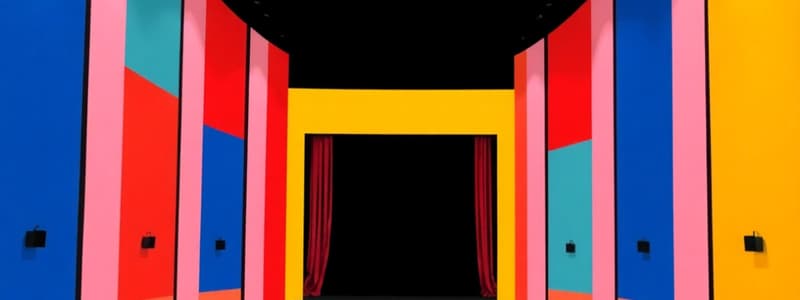Podcast
Questions and Answers
What defines theater as a performance art?
What defines theater as a performance art?
- It is only meant for recorded media.
- It involves live actors performing for a live audience. (correct)
- It requires elaborate special effects.
- It is typically done in closed spaces.
What is a proscenium stage primarily characterized by?
What is a proscenium stage primarily characterized by?
- Being located in an outdoor environment.
- The presence of a proscenium arch framing the stage. (correct)
- Having no specified layout or structure.
- Its circular layout allowing audience access from all sides.
Which type of theater allows the audience to be seated on all sides of the stage?
Which type of theater allows the audience to be seated on all sides of the stage?
- Black box theater
- Proscenium theater
- Thrust theater
- Theater in the Round (correct)
What is a significant challenge of staging a Theater in the Round?
What is a significant challenge of staging a Theater in the Round?
During which historical period was the Theater in the Round primarily developed?
During which historical period was the Theater in the Round primarily developed?
Which of the following is NOT a requirement for staging a Theater in the Round?
Which of the following is NOT a requirement for staging a Theater in the Round?
What differentiates the spelling of 'theater' and 'theatre'?
What differentiates the spelling of 'theater' and 'theatre'?
What is the purpose of the proscenium arch in a theater?
What is the purpose of the proscenium arch in a theater?
What is a characteristic of a thrust stage?
What is a characteristic of a thrust stage?
Which type of theater uses black walls and a black floor?
Which type of theater uses black walls and a black floor?
What distinguishes an Open Air Theatre from other types of theatres?
What distinguishes an Open Air Theatre from other types of theatres?
What is the significance of the proscenium arch in thrust stages?
What is the significance of the proscenium arch in thrust stages?
Which historical era is associated with the creation of thrust stages?
Which historical era is associated with the creation of thrust stages?
What allows the Black Box Theatre to have flexible staging?
What allows the Black Box Theatre to have flexible staging?
What is a feature of the Open Thrust Stage?
What is a feature of the Open Thrust Stage?
Which statement best describes the audience's view in a thrust stage?
Which statement best describes the audience's view in a thrust stage?
Flashcards are hidden until you start studying
Study Notes
Theater Spaces
- Thrust Stage: Combines elements of proscenium and theater-in-the-round
- Audience sits on multiple sides, but not all sides.
- May have a proscenium arch
- Open Thrust Stage: Oldest style, stage house behind the "stage"
- Platform Thrust Stage: Actors elevated above ground, sides of theater space elevated
- Black Box Theatre: Simple and flexible, created during the 20th-century European Avant-garde movement
- Usually has black walls and floor
- Open Air Theatre: No roof
- May incorporate natural light, especially sunset
- Proscenium Stage: Most common type in the United States and Europe
- Created during the Italian Renaissance
- Audience faces the stage on one side
- Has a proscenium arch
- Theater in the Round: Stage is located in the center of the audience.
- Audience on all sides of the stage.
- Created during the Greek and Roman era
- Creates a feeling of involvement
- Proscenium Arch: An arch framing the opening between the stage and the auditorium in some theaters.
Staging/Design
- Theater in the Round:
- Scenery cannot block actors or the stage from the audience.
- Backdrops and curtains cannot be used.
- Lighting design must illuminate actors from all sides without blinding the audience.
Studying That Suits You
Use AI to generate personalized quizzes and flashcards to suit your learning preferences.




